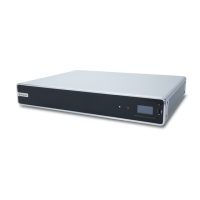SoundStructure Product Family
2 - 9
These three different versions of the input signal mean that, at the same time,
an output signal to the loudspeakers can use the sound reinforcement pro-
cessed version of an input signal, an output signal to the video conferencing
system can use the conferencing processed version of the input signal, and an
output signal to the recording system can use the recording processed version
of the input signal. The decision of which of these three processed version is
used is made at each matrix crosspoint on the matrix as described in the Matrix
Crosspoint section below.
Conferencing Version
The conferencing version will be processed with the acoustic echo and noise
cancellation settings, non-linear signal processing, automatic gain control,
dynamics processing, automixer, fader, delay, and input mute. The conferenc-
ing signal path and summary block diagram is highlighted in the following
figure. This is the path that is typically used to send echo and noise cancelled
microphone audio to remote locations. This is the default processing for micro-
phone inputs when the automixed version of the signal is selected.
Sound Reinforcement Version
The sound reinforcement version will be processed with the echo and noise
cancellation, optional feedback elimination processing, automatic gain con-
trol, dynamics processing, automixer, fader, delay, and input mute. This is the
path that is typically used for sending local audio to loudspeakers in the room
for sound reinforcement. There is no non-linear processing on this path so that
the local talker audio to the loudspeakers is not affected by the presence of
remote talker audio in the local room.
The automatic gain control on the sound reinforcement path is different from
the automatic gain control on the conferencing version of the signal because
the sound reinforcement automatic gain control will not add gain to the signal.
In other words, the sound reinforcement AGC will only reduce the gain of the
input signal. This restriction on the sound reinforcement AGC is to prevent the
Each analog input signal is processed to create three processed versions that can
be used in different ways in the matrix.
Mic or Line
Input
Input to
Matrix
Input to
Matrix
Parametric
Equalization
A/D
Converter
Analog
Gain
Acoustic Echo
Cancellation
Noise
Cancellation
Automatic
Gain Control
Automixer
AGC Dynamics Fader Delay
Fader
Automixer
Automixer
Delay
Automatic
Gain Control
Non Linear
Processing
Feedback
Reduction
Dynamics
Processor
Dynamics
Processor
Fader
Input to
Matrix
Automatic
Gain Control
Fader Delay
Dynamics
Processor
Delay
Mute
Recording/
Ungated
Conferencing
Sound
Reinforcement
C-Series Conferencing Input Processing
Parametric
Equalization
Acoustic Echo
Cancellation
Noise
Cancellation
Automatic
Gain Control
Fader
Automixer
Delay
Non Linear
Processing
Dynamics
Processor
Mute

